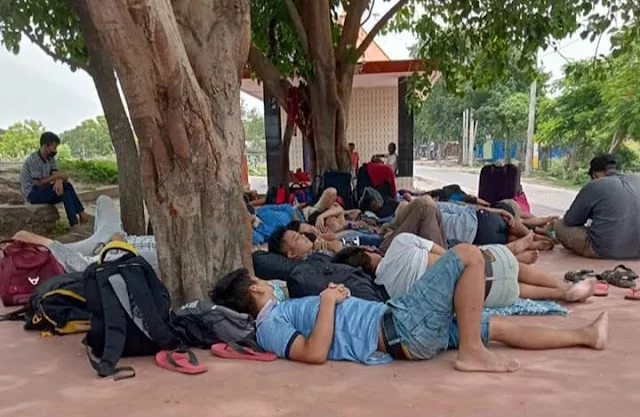Writes Neeraj Zimba Tamang
The most prominent and important structural change in the administration is the grant of political autonomy and statehood in North East India. This process goes back to the British Era when the Interim Government of India had appointed a sub-committee to the Constituent Assembly, viz. North- East Frontier (Assam) Tribal and Excluded Areas Committee under the Chairmanship of first Assam Chief Minister, Gopinath Bardoloi. The committee recommended setting up of autonomous district councils to provide due representative structures at the local level to the tribal population. The recommendation was later incorporated into Sixth Schedule (article 244 (2) & Article 275(1)) of the Indian Constitution.
 |
| Gorkha National Students’ Front (GNSF) march in Darjeeling for Sixth Schedule |
Provisions of the Sixth Schedule As per the Sixth Schedule, the four states viz. Assam, Meghalaya, Tripura and Mizoram contain the Tribal Areas which are technically different from the Scheduled Areas. Though these areas fall within the executive authority of the state, provision has been made for the creation of the District Councils and regional councils for the exercise of the certain legislative and judicial powers. Each district is an autonomous district and Governor can modify / divide the boundaries of the said Tribal areas by notification. Currently, there are ten such Councils in the region as listed below:
Assam Bodoland Territorial Council Karbi. Anglong Autonomous Council Dima Hasao. Autonomous District Council Garo Hills.
Autonomous District Council Jaintia Hills. Autonomous District Council Khasi Hills. Autonomous District Council of Tripura
Mizoram Chakma Autonomous District Council Lai Autonomous District Council
Mara Autonomous District Council.
Analysis: Assessment of Sixth Schedule in North East First, we should note that the Sixth Schedule was primarily adopted to address the political aspirations of the Nagas. But the Nagas refused it because they said it was too little. The Sixth schedule lays down a framework of autonomous decentralized governance with legislative and executive powers over subjects like water, soil, land, local customs and culture. The Legislations passed by the Autonomous councils come into effect only after the assent of the Governor. Except Tripura and Bodoland councils, these bodies have also been given judicial powers to settle certain types of civil and criminal cases also. Thus, the councils under the sixth schedule have been given more power than the local governments under the 73rd and 74th amendments in the rest of the country. It has been established that this autonomy paradigm has brought a degree of equilibrium within the tribal societies mainly via the formal dispute resolution under customary laws and through control of money-lending etc. In Assam, Tripura and Mizoram, the autonomous councils have power to decide if a State legislation on subject matters under the autonomous councils should apply to their territories or not. Similarly, the Union legislations on similar subjects can be excluded from applying to these areas by the State Government in Assam and the union Government in the other two States. However, there are certain issues due to which the sixth schedule has ended up creating multiple power centers instead of bringing in a genuine process of democratization or autonomy in the region.
They are as follows: Conflict of Power
There are frequent conflicts of interest between the District Councils and the state legislatures. For example, in Meghalaya, despite the formation of the State, the whole of the State continues to be under the Sixth Schedule causing frequent conflicts with the State Government. Para 12 (A) of the Sixth Schedule clearly states that, whenever there is a conflict of interest between the District Councils and the state legislature, the latter would prevail. Thus state enjoys the superiority, but then it is alleged that autonomous councils are mere platforms for aspiring politicians who nurture ambitions to contest assembly polls in the future. Disparity among Autonomous Bodies and Local Bodies This is another important area of conflict. The local bodies established via Seventy-third Amendment are more liberally funded through the State Finance commissions. In a state where there are more than one autonomous councils; one claims that it is being treated less favourably than other. For example, in Assam, there is a perceived preferential treatment to Bodoland Territorial Council in matters of budget allocations. Functioning of Governor The Legislations passed by the Autonomous councils come into effect only after the assent of the Governor.
However, Governor works as per the aid and advice of the state Council of Ministers. This makes many a times, the autonomous councils irrelevant as far as power to legislate is concerned. Remedies to Sixth Schedule problems several measures can be taken up as remedy to above problem.
Firstly, there is a need that Sixth Schedule is amended and Autonomous Councils are made to benefit from the recommendations of the state finance commission.
Secondly, state governments and the Autonomous Councils should identify powers under the Sixth Schedule that Governors may exercise at their discretion without having to act on the ‘aid and advice’ of the Council of Ministers.
Thirdly, the administration of the district autonomous councils should be periodically reviewed by a commission under Union Government.
Gorkha National Students’ Front (GNSF) is the student wing of the Gorkha National Liberation Front’s (GNLF)





